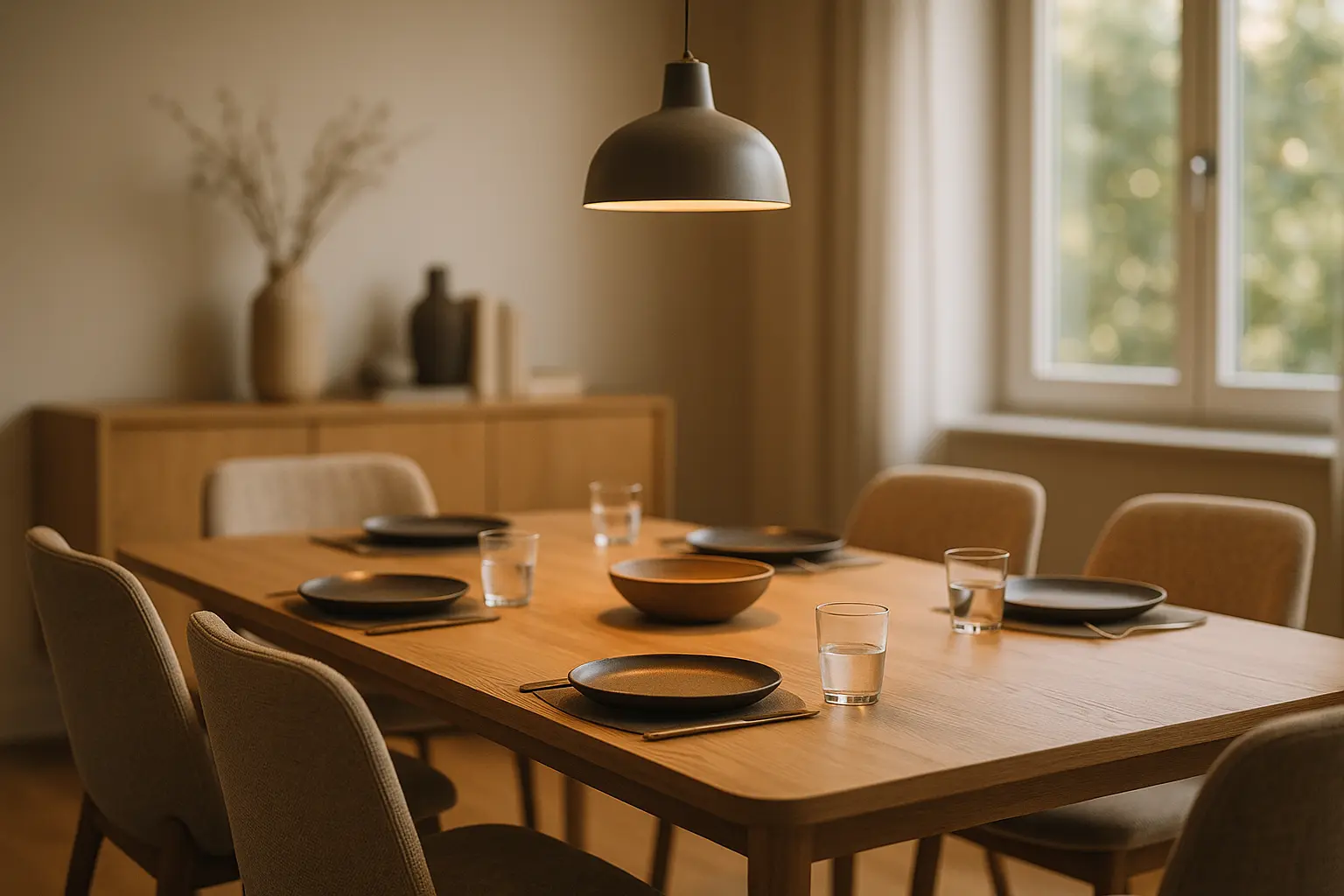In the ever-evolving landscape of interior design, dining rooms play a pivotal role in shaping our daily experiences and social gatherings. Dining spaces are no longer just areas designated for meals; they have transformed into dynamic arenas for connection and creativity. With a blend of modern aesthetics and classic elements, these rooms are a testament to our desire for both comfort and style. As we delve into this fascinating evolution, let’s explore how to create a dining room that is both convivial and functional.
Crafting the Perfect Layout
Embarking on the journey of designing a dining room begins with understanding the space at our disposal. The layout forms the foundation of an inviting environment, striking a balance between style and functionality.
By positioning the table at the center, we create a natural focal point. Choosing the right size and shape of the table is crucial. Round tables foster intimacy and conversation, while rectangular ones offer versatility for larger gatherings. The furniture arrangement should encourage flow. We need to consider the movement of guests and the accessibility of seats, ensuring everyone enjoys a seamless experience.
Chairs are not just functional; they contribute significantly to the room’s aesthetic. Comfortable yet stylish seating can elevate the dining experience. Mixing and matching chairs can add a touch of modern flair, but harmony in design is essential.
Finally, let’s not overlook the walls. Art pieces, whether contemporary or classic, inject personality. A well-chosen artwork can stir conversation and add layers of interest to the room. Credits for these elements go to our keen eye for detail and creativity. Combining these components effectively leads to a layout that not only looks stunning but enhances our daily lives.
Lighting: The Heartbeat of the Dining Room
Lighting breathes soul into a dining room, setting the tone for every occasion. It is not merely about illuminating the space; it’s about creating an ambiance that resonates with our guests. From soft, warm glows for romantic dinners to bright, vibrant settings for festive gatherings, lighting is the unsung hero of dining room design.
Central to our discussion is the light fixture above the table. An elegant chandelier or a cluster of modern pendant lights can become a statement piece, drawing the eye and anchoring the room. The choice of lighting should complement the overall style and theme of the space.
Layered lighting is a technique that brings depth and versatility. Wall sconces and floor lamps can enhance the ambiance, while dimmable options allow us to adjust the mood effortlessly. Consider the natural light sources too. Utilize windows and glass features to invite daylight, creating a seamless transition from day to night.
Incorporating smart lighting solutions aligns with our modern ethos. With the touch of a button or a voice command, we can control the intensity and hue of lights, adapting the space to different needs. This blend of technology and design heralds a new era in dining experiences.
Infusing Style with Art and Decor
Art and decor are the storytellers of a dining room, reflecting our tastes and interests. A dining space adorned with carefully curated pieces can transform into a gallery, offering a feast for the eyes alongside the culinary delights.
Art is a powerful medium. Large, bold canvases can dominate a wall, becoming a conversation starter, while smaller pieces can be used to create a cohesive gallery display. The choice of art should resonate with our personal style and the broader theme of the room. Classic landscapes, abstract pieces, or modern minimalistic works can all find their place with the right framing and positioning.
Decor extends beyond art. Consider using textiles for an added layer of warmth and texture. Rich table runners, wall tapestries, or even a classic rug can anchor the space and introduce color.
Greenery, too, plays a pivotal role. Plants and floral arrangements infuse life and vibrancy, bridging the gap between the indoor and outdoor worlds. This natural element can soften the edges of modern designs, creating a welcoming and relaxed atmosphere.
In this age of personalization, our homes are canvasses that reflect our unique identities. By thoughtfully selecting art and decor, we create a room that not only looks beautiful but feels intimately ours.
The Interplay of Classic and Modern Styles
In the realm of interior design, blending the old with the new creates a harmonious balance that resonates with our contemporary sensibilities while paying homage to timeless elegance. The dining room is a perfect canvas for this fusion of classic and modern styles.
Classic elements, such as ornate moldings, vintage furniture, and rich wood finishes, offer a sense of history and gravitas. These features bring warmth and depth, inviting us to linger and savor each moment. Incorporating classic touches requires a respectful nod to the past, ensuring that they enhance rather than overpower the space.
Conversely, modern designs emphasize clean lines, simplicity, and functionality. Sleek furniture, minimalist lighting, and innovative materials speak to our desire for efficiency and clarity. The modern aesthetic is about reducing clutter and focusing on the essentials, creating a space that feels open and breathable.
The magic happens when we skillfully marry these styles. Picture a polished wooden table paired with acrylic chairs, or a contemporary pendant light illuminating a vintage sideboard. This interplay encourages creativity, allowing us to explore new ideas while staying grounded in familiar comforts.
In designing a dining room that celebrates both the past and the present, we craft a space that is not only visually stunning but also rich in narrative. It is a testament to our evolving tastes and an ode to enduring traditions.
As we conclude our exploration of dining room trends, it’s clear that these spaces are more than mere backdrops for meals. They are vibrant ecosystems where style, functionality, and personal expression intertwine. By carefully selecting furniture, lighting, art, and decor, we create environments that are both convivial and functional.
Our dining rooms have become arenas of connection, where memories are forged and stories are shared. Embracing this dual role of elegance and practicality, we pave the way for spaces that not only look stunning but feel inviting.
In this realm of design, there are no rigid rules, only opportunities to express our individuality. Whether infusing modern simplicity or celebrating classic grandeur, the ultimate goal is to craft an environment that resonates with us and our guests.
Here’s to dining rooms that are so much more than their walls; they are expressions of who we are. Let these ideas inspire a journey of creativity and transformation in your own home, where every meal becomes a feast for the senses.
FAQ
What are the current trends in dining room design?
The latest trends in dining room design emphasize creating spaces that are both inviting and practical. This includes the use of multifunctional furniture, open layouts that encourage socializing, and incorporating natural materials for a warm and cozy atmosphere.
How can I make my dining room more functional?
To enhance functionality, consider using extendable tables that can accommodate larger gatherings, incorporate storage solutions like sideboards or shelving, and choose seating that is both comfortable and easy to move around.
Which materials are popular in modern dining room designs?
Natural materials such as wood, stone, and metal are popular choices for modern dining rooms. These materials not only add a touch of elegance but also contribute to a sustainable and eco-friendly environment.
What color schemes are ideal for a convivial dining room?
Warm and neutral colors, such as soft browns, earthy greens, and muted blues, are ideal for creating a welcoming dining room. These hues help establish a calming ambiance that encourages relaxation and conversation.
How can lighting impact the dining room atmosphere?
Proper lighting is crucial in setting the mood of a dining room. Consider using a combination of overhead lights, pendant fixtures, and candles to create a layered lighting effect that can be adjusted for different occasions, from intimate dinners to lively gatherings.


